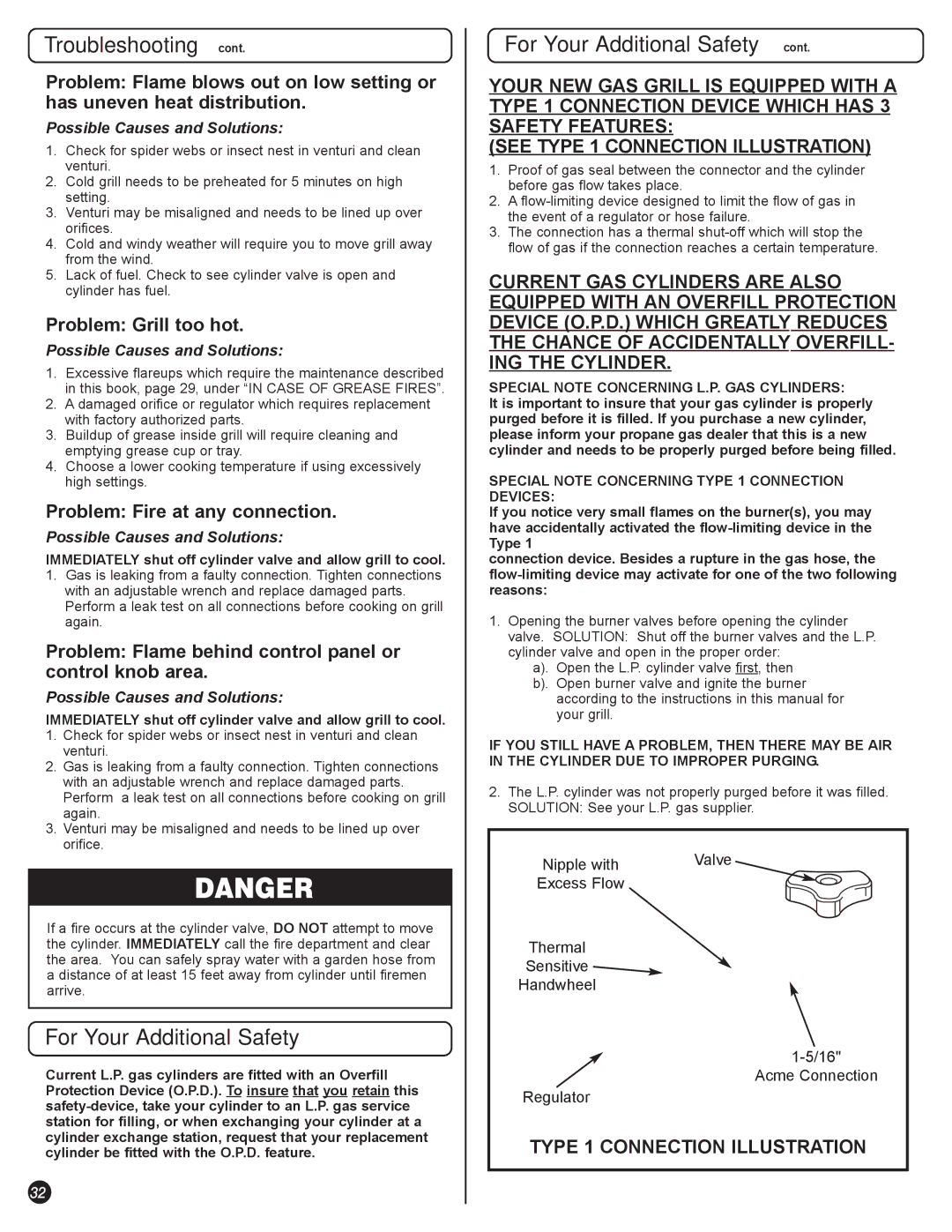
Troubleshooting cont.
Problem: Flame blows out on low setting or has uneven heat distribution.
Possible Causes and Solutions:
1.Check for spider webs or insect nest in venturi and clean venturi.
2.Cold grill needs to be preheated for 5 minutes on high setting.
3.Venturi may be misaligned and needs to be lined up over orifices.
4.Cold and windy weather will require you to move grill away from the wind.
5.Lack of fuel. Check to see cylinder valve is open and cylinder has fuel.
Problem: Grill too hot.
Possible Causes and Solutions:
1.Excessive flareups which require the maintenance described in this book, page 29, under “IN CASE OF GREASE FIRES”.
2.A damaged orifice or regulator which requires replacement with factory authorized parts.
3.Buildup of grease inside grill will require cleaning and emptying grease cup or tray.
4.Choose a lower cooking temperature if using excessively high settings.
Problem: Fire at any connection.
Possible Causes and Solutions:
IMMEDIATELY shut off cylinder valve and allow grill to cool.
1.Gas is leaking from a faulty connection. Tighten connections with an adjustable wrench and replace damaged parts. Perform a leak test on all connections before cooking on grill again.
Problem: Flame behind control panel or control knob area.
Possible Causes and Solutions:
IMMEDIATELY shut off cylinder valve and allow grill to cool.
1.Check for spider webs or insect nest in venturi and clean venturi.
2.Gas is leaking from a faulty connection. Tighten connections with an adjustable wrench and replace damaged parts. Perform a leak test on all connections before cooking on grill again.
3.Venturi may be misaligned and needs to be lined up over orifice.
![]() DANGER
DANGER
If a fire occurs at the cylinder valve, DO NOT attempt to move the cylinder. IMMEDIATELY call the fire department and clear the area. You can safely spray water with a garden hose from a distance of at least 15 feet away from cylinder until firemen arrive.
For Your Additional Safety
Current L.P. gas cylinders are fitted with an Overfill Protection Device (O.P.D.). To insure that you retain this
32
For Your Additional Safety cont.
YOUR NEW GAS GRILL IS EQUIPPED WITH A TYPE 1 CONNECTION DEVICE WHICH HAS 3 SAFETY FEATURES:
(SEE TYPE 1 CONNECTION ILLUSTRATION)
1.Proof of gas seal between the connector and the cylinder before gas flow takes place.
2.A
3.The connection has a thermal
CURRENT GAS CYLINDERS ARE ALSO EQUIPPED WITH AN OVERFILL PROTECTION DEVICE (O.P.D.) WHICH GREATLY REDUCES THE CHANCE OF ACCIDENTALLY OVERFILL- ING THE CYLINDER.
SPECIAL NOTE CONCERNING L.P. GAS CYLINDERS:
It is important to insure that your gas cylinder is properly purged before it is filled. If you purchase a new cylinder, please inform your propane gas dealer that this is a new cylinder and needs to be properly purged before being filled.
SPECIAL NOTE CONCERNING TYPE 1 CONNECTION DEVICES:
If you notice very small flames on the burner(s), you may have accidentally activated the
connection device. Besides a rupture in the gas hose, the
1.Opening the burner valves before opening the cylinder valve. SOLUTION: Shut off the burner valves and the L.P. cylinder valve and open in the proper order:
a). Open the L.P. cylinder valve first, then b). Open burner valve and ignite the burner
according to the instructions in this manual for your grill.
IF YOU STILL HAVE A PROBLEM, THEN THERE MAY BE AIR IN THE CYLINDER DUE TO IMPROPER PURGING.
2.The L.P. cylinder was not properly purged before it was filled. SOLUTION: See your L.P. gas supplier.
Nipple with | Valve |
Excess Flow |
|
Thermal
Sensitive ![]()
Handwheel
Regulator
TYPE 1 CONNECTION ILLUSTRATION
